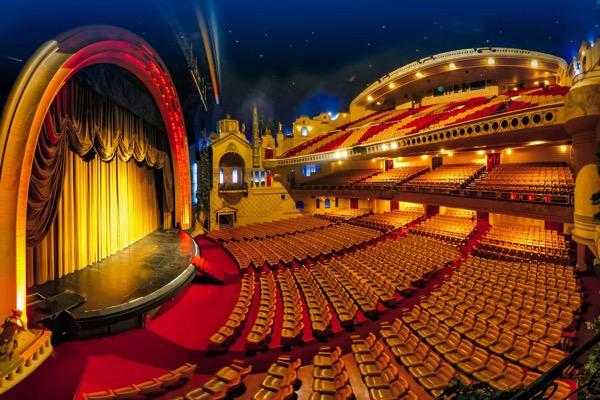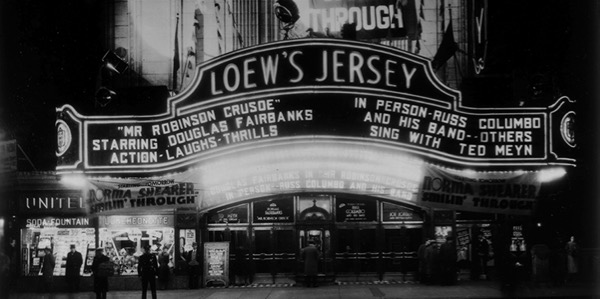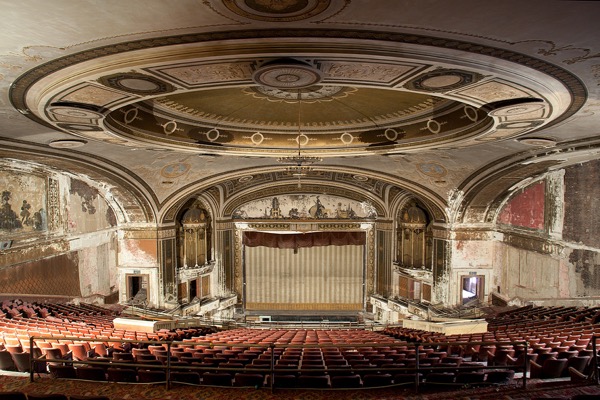It's May 1977, and I've been on a six hour line with my High School buddy.Yes that's right we are about to enter into the heavenly realm of Lowes Astor Theater to have our jaws drop to the floor upon viewing the opening scene of Star Wars. I'm 60, and have a full Home Theater (Projector, Screen, 5.2.2 Dolby Atmos) and yet, I will be back to the experience big movies on the real big screen of a Dolby Cinema Theater. Luckily, there is no more waiting in line with pre-purchased tickets.
Movie Theaters: The Way They Were

Once upon a time the movie on the screen was only part of a theater experience; the theater itself was often part of the show. A few years after that canine-caused cry-in my uncle would take me to see whatever was playing at New York’s Radio City Music Hall on school vacations (I grew up in Connecticut but we still had relatives in the city). That theater was and remains a wonder. In those years it combined a movie and a stage show. It no longer shows movies, but instead features concerts and other live events off and on throughout the year.
But I digress. In an unplanned visit to the lower shelves of my mostly video- and CD-filled bookcase I found a large, heavily-illustrated, footnoted, indexed, and long forgotten book about the history of the movie exhibition trade, from both its business and architectural perspectives: Cinema Treasures: A New Look at Classic Movie Theaters by Ross Melnick and Andreas Fuchs. Before you get too excited, the book will be hard to find, though there were a few (used ) listings for it on Amazon at up to $60. I wouldn’t be surprised if most of the original printing from 2004 was snapped up by custom home theater installers to give their clients ideas. If you can find one, either on line or in the dusty reaches of a well-stocked bookstore (a breed now as rare as the movie palace), and are interested in the subject, snatch it up immediately. You won’t regret it. Mine will never be for sale; I haven’t yet fully digested it.

The history of movies themselves has been exhaustively documented. But the history of movie theaters, and the often brilliant entrepreneurs who made them happen through success and sometimes failure, is harder to find. One interesting anecdote from the book involves the early Warner brothers and sisters. You’ve heard of Warner Brothers, I assume, but likely little of their roots. In 1903 they opened a nickelodeon, the 99-seat Cascade Theater in Newcastle, Pennsylvania. “Sam was the theater’s projectionist, Sadye took the tickets, Rose accompanied the films on the piano, Harry and Albert took care of administrative details, and Jack reportedly sang and performed dramatic sketches.”
Early movie presentations were often combined with the then dominant form of live theatrical entertainment, vaudeville. But the development of quality theatrical movie presentations is perhaps best linked to a man you’ve probably never heard of Samuel Rothafel. He appears almost 25 times in the book’s index. Rothafel combined movies with appropriate music for the silent films of the era (in some cases by a full orchestra), together with other innovations. His shows, far more compelling than what most of the nickelodeons of the period offered, drew in big audiences. In a few short years, after modest beginnings with his own first theater in the small coal-mining town of Forest City Pennsylvania, his advice was sought after by theater owners across the country. Rothafel is best known by his nickname, Roxy. His influence was prominent for decades, culminating in the early 1930s with two iconic movie palaces in New York City, the Roxy (long since demolished) and the above mentioned Radio City Music Hall, each of them offering nearly 6000 seats. The Roxy came first, but in a later (friendly?) rivalry (probably a show-biz legend) between the two theaters for the claim to the most seats, Rothafel counted every seat he could find in Radio City Music Hall, including the chairs in the dressing rooms!
Similar movie palaces graced major cities (and some minor ones as well) from around 1915 to early in Great Depression of the 1930s. Thousands of them were built , and much of the book is devoted to their stories. But after their heyday in the late 1920s, thousands of them were closed and many demolished. A few remain today, however, including Radio City Music Hall, through uses other than film presentations.
The book also covers the era from the decline of the movie palaces to the near-present detail, reminding us that change, often unexpected, are perhaps the only sure thing after death and taxes. The film and theater business has weathered more than a few disruptions: the introduction of sound in the late 1920s, the Depression, and WWII. The latter cut deeply into overseas revenues, though U.S. attendance of 90 million per week held up, likely helped along by low ticket prices (about 30 cents in 1945, or a bit under $4.00 in today’s money) and the need to escape, if only for a few hours, the Depression and later the war.

After the war other trials hit the movie industry. In an anti-trust action the studios were forced to divest their studio-owned theaters, once a major source of their income. Then, of course, came television. Technical developments did help soften the blows, including wider use of color, 3D (briefly, despite its popping out periodically over the ensuing decades) and various forms of widescreen none of which early television offered. The near-modern era also saw the drive-in (less prevalent now, but something of a revelation in the ‘50s as it was cheap to “build"). Theaters also made their way into another new craze, the shopping center. Then the multiplex, offering multiple screens inside the same facility, largely replaced the stand-alone theaters that dominated the first half century of film exhibition.
The book ends in 2004, but today there’s increasing concern about the viability of the movie theater experience after we eventually emerge from the current pandemic. Today’s theaters are faced with perhaps the greatest challenge in their history. Most of them have been closed for months, with no revenue coming in but their rent still due (most theaters rent the space or have a mortgage on it; they don’t own it outright). When they re-open it’s unlikely that audiences will feel truly comfortable until there’s an effective Covid-19 vaccine.
But theaters will come back eventually, though perhaps on a smaller scale. They might have new owners. Even if one or more of them go bankrupt, the equipment and infrastructure is still there for someone else to pick up. There’s not a huge secondary market for used theater projectors, huge sound systems, theater seats, popcorn machines, and the huge retail footage that their multiplexes occupy.
Older audiences and those with real home theaters (not just a 38-inch TV and a soundbar) may prefer to stay at home and Netflix (soon to become a verb, if it isn’t already!). But few families have a home theater setup that can begin to challenge even an ordinary theater much less IMAX or Dolby Cinema. And even if Dad has a knockout home theater, is his 18-year-old going to bring his GF home every time they want to see a movie, with parents and siblings hanging around? I think not. In most smaller or medium-sized cities a movie is still a featured weekend entertainment for those in their late teens or early 20s who made up the bulk of the movie audience even BC (Before Covid). I don’t see that changing permanently.
- Log in or register to post comments


Am I saddened by the closure of theaters...yes. However as you know, my home theater can outperform the lack luster stuff that I have at my end of NWFL (Now the Naval Aviation Museum...they have a theater). I'm not in a rush to return...I want new content, but yes - I want to feel safe. Mulan is supposed to open on Sept 4th on Disney+ 4K Atmos, for $30...that's about how much I pay anyway to go to the movies and my concessions are much cheaper. 110 inches 4k with 7.4.4 isn't bad at all, this might turn into my new norm if they release first run movies this way. Mulan will be the second first run movie that I've purchased.

First of all...it was on my must see list ($30 for my wife and I to get tickets). If I like it - then it would go on my must buy list, 4k would cost me about $28 for the disc. All the while still having Disney + anyway for upcoming Marvel MCU content and Star Wars Mandalorian. So I'd have Disney + anyway. So I either spend $58 and have Disney + or spend $30 and have Disney + and have the movie eventually go to the free streaming anyway....and there's always VUDU for purchasing at a later date for less. It depends on your situation ...and I'm not an Apple guy...sorry.

No dog, and I wasn't a kid...
The most memorable movie theater experience ever for me was at a local theater that only screened past-their-expiration-date and even older movies. On one of their screens, they had weekend showings of really old classic movies.
The best ever was a showing of the original Phantom of the Opera with Lon Chaney. This version had the original color scenes (very few) and they weren't exactly Technicolor.
However, the best aspect was the sound. This Phantom was a silent movie, of course. But, instead of a pianist, the theater had a special event where the sound was provided by a mostly robotic orchestra. That sounds crazy, but believe me it wasn't. Real instruments were used, just not played by real people. The people on the screen weren't real, either, so it seemed like a reasonable match.
Here's the sound provider: http://www.pamband.com There's some YouTube clips available.
The point is, it would be almost impossible to reproduce this experience in a home theater, no matter how great the home theater is. Yeah, this is somewhat unique and not your normal movie going experience. But, it shows the power of what is possible. Even without a dog involved.

I am 42. I have gone to my fair share of movies in theaters both as a child and an adult, as well as having seen plenty of movies solely on my own screen (1080p DLP projector, 106" screen, 5.1 channel sound, Blu-Ray).
There have certainly been some amazing experiences in theaters. Ones that stand out particularly are Lawrence of Arabia in 70mm at the Chicago Music Box Theater. I also vividly recall seeing The English Patient downtown in Chicago. 1989's Batman was a nearly religious experience for a 12 year-old me.
With that said, the modern "non-art-film" theater going experience is quite lackluster. I recall watching Fellowship of the Ring in the theater, and having my chair kicked from behind the entire time. Watching Star Wars Episode IX in the theater was an exercise in endurance - both the 40 minutes of previews as well as the interminable FX-blender plot.
Frankly, the only reason new release movies get even a consideration from me is their exclusivity. If they were released day and date on disc or streaming, I would opt for that, because my home theater is far more comfortable, has better climate and volume control, can be paused for a bathroom break, has fewer commercials, and has far cheaper snacks. Generally speaking, I just wait for the disc (recent movies that went this route were Knives Out, Parasite, and Solo).
If theater venues want to compete with the home when they reopen, they need to offer a better experience. Assigned seats are a good start. Intermissions would be really nice so that the viewer need not play Bathroom Chicken with a 2.5 hour movie. I think by far the worst aspect of the modern experience is how much of my time they waste with commercials and previews (which also plays into the bathroom concern). They should start precisely at their listed times, giving people the option of arriving early or not. Otherwise, they'll just have to rely on restricted viewing windows as a cudgel to force people to attend.

Excellent post! I sat near someone with stinky feet - feet propped up on the bar in front of him during "Infinity War" and then he shook his feet flopping his shoes releasing the "soul stank" repeatedly during the movie! Then down from my wife, there was this guy that looked old, and wailed at each death scene in the movie........I feel ya!!!!

I'm a Baby Boomer, and have seen my share of Cinemas. I grew up in the Los Angeles, CA area near the Movie Capital of the world - Hollywood. Went to Cinemas like Grauman's Chinese Theatre, Pantages Theatre, RKO Theatre, and some others. Now I might go once a year, and the Theatre experience is still good but my Home Theater with a big screen 4K Sony is sometimes way better! We'll have to see what shakes out in the Movie Industry!

Endless live action comic book hero movies and Disney squeezing every last cent out of the Star Wars franchise doesn't make me miss going to the movies.
























































